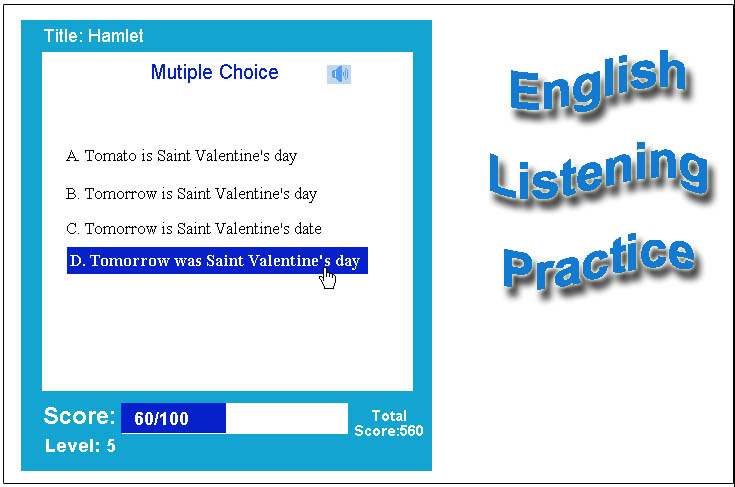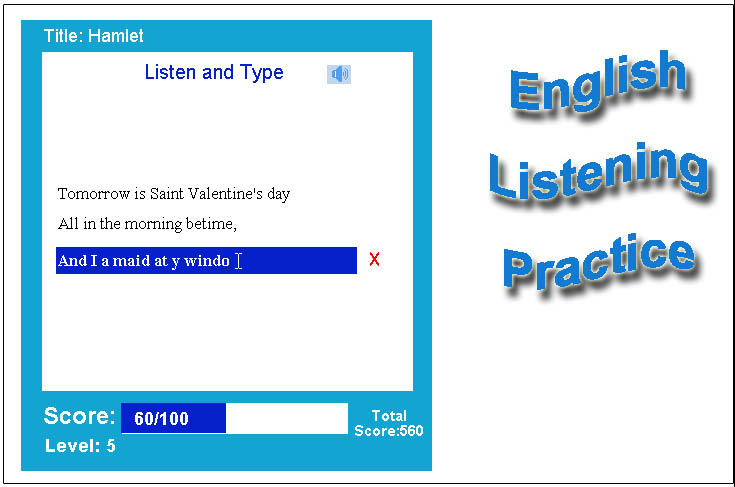ProjectProposal-Kai Lin Huang
From CS 160 Fall 2008
Name: English Listening Game
Contents |
Target User Group
ESL learners and even kindergarten children are the main groups of users because they are learning the English language and need practice.
Problem Statement
Think of the head of a household has a hard time catching up with English speakers, improving his or her English skills will significantly help him or her earns more income with a better job and support his or her family. Many ESL (English as a Second Language) students and adults have a hard time in understanding oral English even if they have learned every words of the said sentence. The lack of systematic practice is one of many reasons that they improve this skill slowly.
Problem Context and Forces
Background of the problem
Understanding oral English sounds easy, and only few resources are available. However, misunderstanding of a sentence would lead to serious consequences if it’s life threatening message or critical warning. There are some resources for English learners such as audio and video tapes from non-profit organizations like schools and public libraries. However, given that ESL learners do not have adequate English language skills to find what they exactly need, they may stick at some levels and cannot find a way to improve their skills further.
Existed solutions
- Some private corporations and public schools that range from elementary schools to community colleges offer ESL classes for youth and adults. However, ESL learners must have very strict time commitment with the schools and classes, which make learning in school an unavailable option for adults who need to work to support their families.
- Public libraries offer limited audio and video tapes on English learning. In addition, these media only widely define the beginner, intermediate and advance English skill level with different standards, thus making them hard to fit learners’ skill levels.
- There is a very rare website Audio Concentration Games that I found with computer a flash listening game that pronounces similar words for users to distinguish them.
Solution Sketch
This game will be designed to help English learners practice listening in a systematic way. It will load and read text files while taking a user’s keyboard or mouse input to identify whether they have handled a certain level of listening skills. The game will have an interface for developers from various countries to translate it into multi-lingual versions for users.
Game procedure
- There are N numerical levels (N>3) and one advance level of the listening skills. “First/1” is the starting level, and N is the highest numerical level.
- For each level that the user chooses, the game will load a random text from the corresponding set of text to read. These sets of texts are preinstalled when the user installs the game.
- After a user accumulates 100 points, he/she can advance to the next level.
- If the user loses to less than 100 points, then he/she will be downgrade to a lower level unless he/she is at level 1.
- After getting to “advance” level, no matter how many mistakes users make, no downgrade will occur. Users can choose to play the game at any level if they reach “advance” level.
Users are free to add more text to the text library. Users can choose to rank the text as any level of the existing levels.
Two small games are embedded within this listening game application. Users at any level are free to choose any one of them to play.
The Multiple Choice Game:
This game reads one sentence at a time from a text, and the screen will show a list of four options for user to choose. Rules:
- Only one of the options is being read, and all other options are variations of the correct option. For example, any noun or adjective is replaced with a word of similar spelling or pronunciation AND of the same part of speech.
- If the user chooses a correct one, he/she will earn 10 points. Otherwise, the user will lose 10 points, and the game screen will highlight the correct answer.
The Listen & Type Game
Each round the game reads a whole text or 25 sentences, whichever is shorter. Users input what they heard and press “Enter” during or after each sentence is read. Rules:
- If the user enters the entire sentence correctly, the game will continue to read the next sentence.
- If the user enters the sentence incorrectly, the game will highlight the current sentence for user to make changes. The interpreter will check the user’s input after the user hits “enter”. Users only have one chance to correct each typed sentence.
- The next sentence will not be read until the user gets the current sentence correct or the correct answer is displayed.
- Each correct sentence is awarded 10 points.



